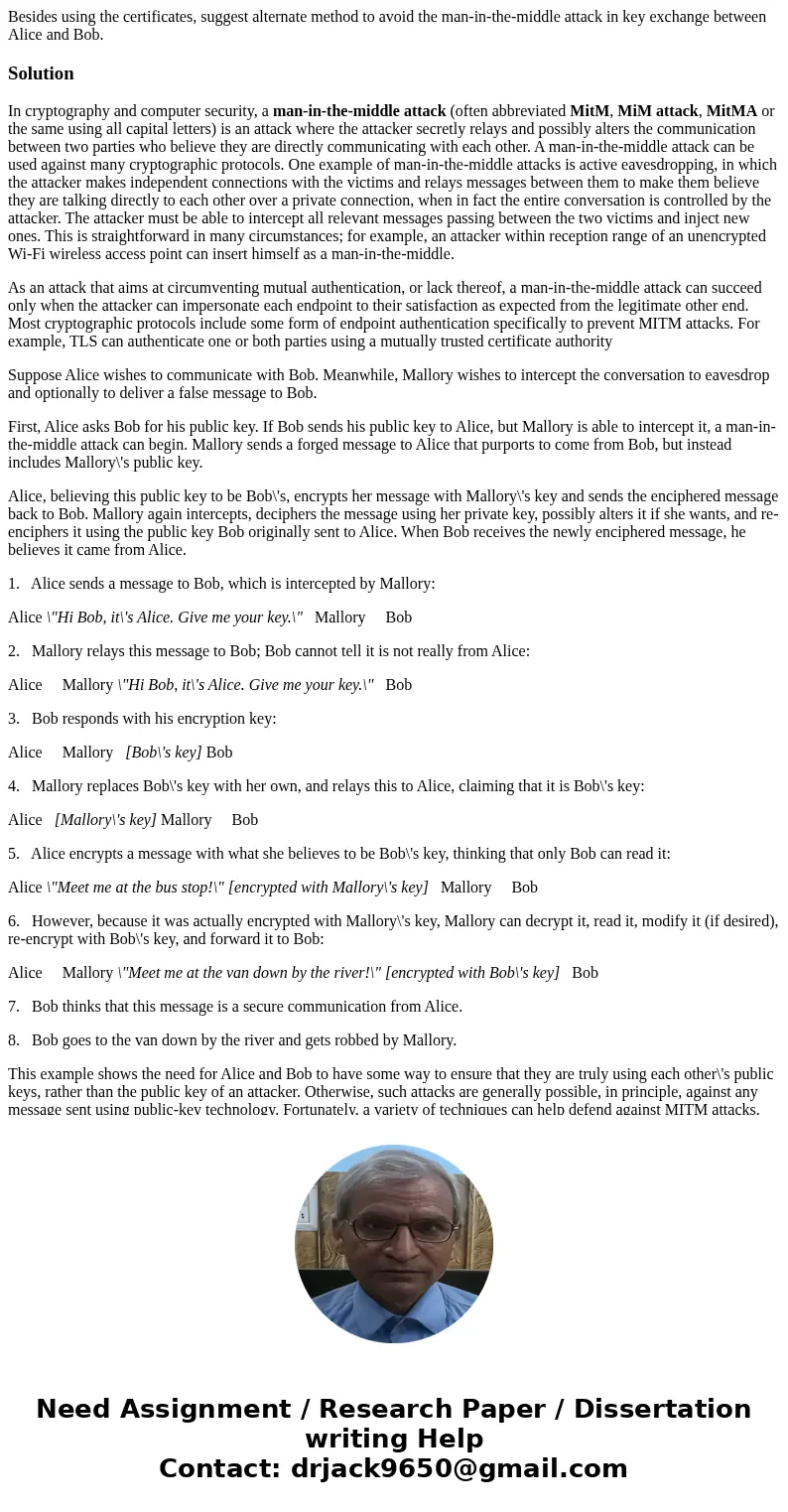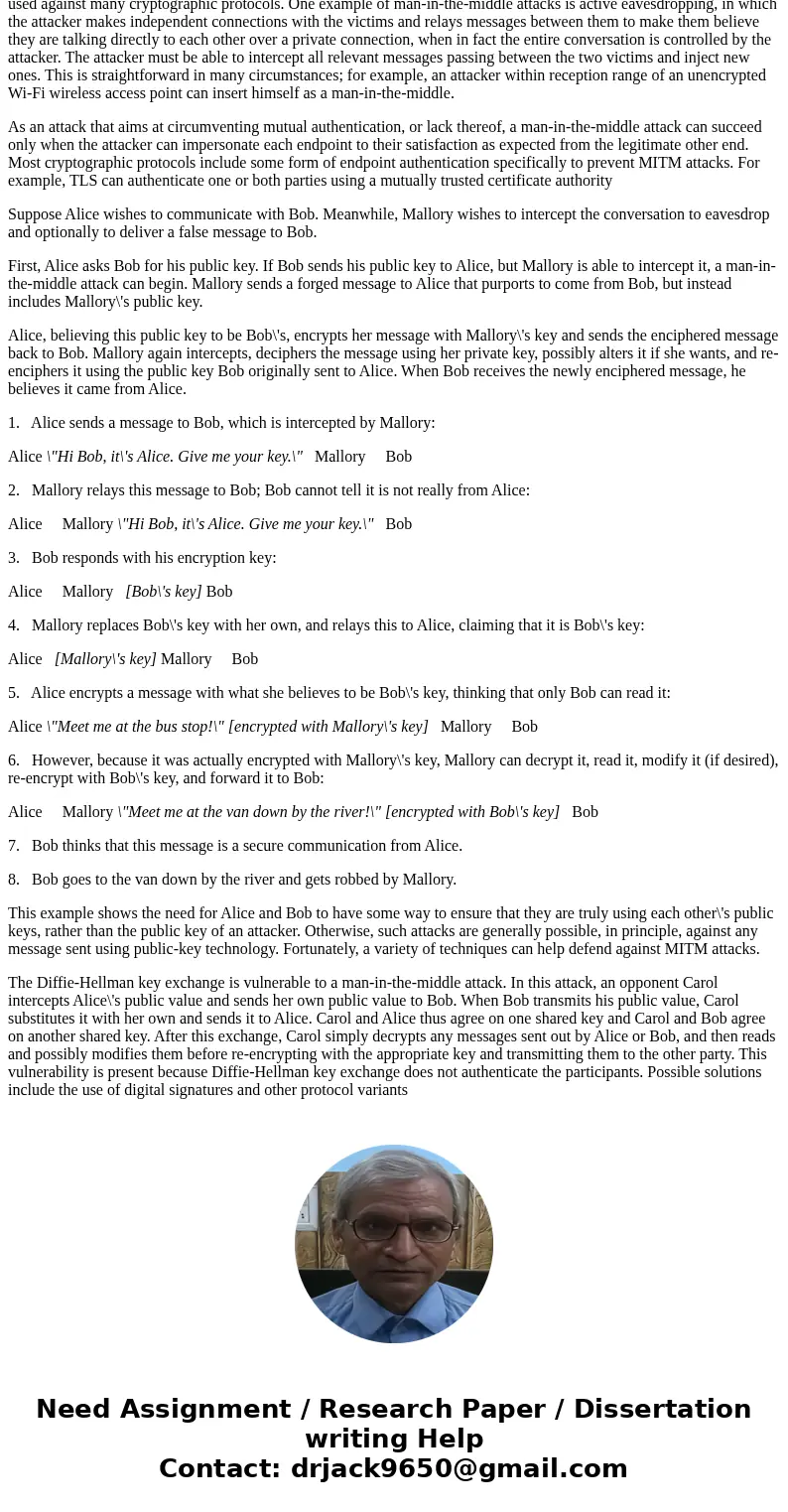Besides using the certificates suggest alternate method to a
Besides using the certificates, suggest alternate method to avoid the man-in-the-middle attack in key exchange between Alice and Bob.
Solution
In cryptography and computer security, a man-in-the-middle attack (often abbreviated MitM, MiM attack, MitMA or the same using all capital letters) is an attack where the attacker secretly relays and possibly alters the communication between two parties who believe they are directly communicating with each other. A man-in-the-middle attack can be used against many cryptographic protocols. One example of man-in-the-middle attacks is active eavesdropping, in which the attacker makes independent connections with the victims and relays messages between them to make them believe they are talking directly to each other over a private connection, when in fact the entire conversation is controlled by the attacker. The attacker must be able to intercept all relevant messages passing between the two victims and inject new ones. This is straightforward in many circumstances; for example, an attacker within reception range of an unencrypted Wi-Fi wireless access point can insert himself as a man-in-the-middle.
As an attack that aims at circumventing mutual authentication, or lack thereof, a man-in-the-middle attack can succeed only when the attacker can impersonate each endpoint to their satisfaction as expected from the legitimate other end. Most cryptographic protocols include some form of endpoint authentication specifically to prevent MITM attacks. For example, TLS can authenticate one or both parties using a mutually trusted certificate authority
Suppose Alice wishes to communicate with Bob. Meanwhile, Mallory wishes to intercept the conversation to eavesdrop and optionally to deliver a false message to Bob.
First, Alice asks Bob for his public key. If Bob sends his public key to Alice, but Mallory is able to intercept it, a man-in-the-middle attack can begin. Mallory sends a forged message to Alice that purports to come from Bob, but instead includes Mallory\'s public key.
Alice, believing this public key to be Bob\'s, encrypts her message with Mallory\'s key and sends the enciphered message back to Bob. Mallory again intercepts, deciphers the message using her private key, possibly alters it if she wants, and re-enciphers it using the public key Bob originally sent to Alice. When Bob receives the newly enciphered message, he believes it came from Alice.
1. Alice sends a message to Bob, which is intercepted by Mallory:
Alice \"Hi Bob, it\'s Alice. Give me your key.\" Mallory Bob
2. Mallory relays this message to Bob; Bob cannot tell it is not really from Alice:
Alice Mallory \"Hi Bob, it\'s Alice. Give me your key.\" Bob
3. Bob responds with his encryption key:
Alice Mallory [Bob\'s key] Bob
4. Mallory replaces Bob\'s key with her own, and relays this to Alice, claiming that it is Bob\'s key:
Alice [Mallory\'s key] Mallory Bob
5. Alice encrypts a message with what she believes to be Bob\'s key, thinking that only Bob can read it:
Alice \"Meet me at the bus stop!\" [encrypted with Mallory\'s key] Mallory Bob
6. However, because it was actually encrypted with Mallory\'s key, Mallory can decrypt it, read it, modify it (if desired), re-encrypt with Bob\'s key, and forward it to Bob:
Alice Mallory \"Meet me at the van down by the river!\" [encrypted with Bob\'s key] Bob
7. Bob thinks that this message is a secure communication from Alice.
8. Bob goes to the van down by the river and gets robbed by Mallory.
This example shows the need for Alice and Bob to have some way to ensure that they are truly using each other\'s public keys, rather than the public key of an attacker. Otherwise, such attacks are generally possible, in principle, against any message sent using public-key technology. Fortunately, a variety of techniques can help defend against MITM attacks.
The Diffie-Hellman key exchange is vulnerable to a man-in-the-middle attack. In this attack, an opponent Carol intercepts Alice\'s public value and sends her own public value to Bob. When Bob transmits his public value, Carol substitutes it with her own and sends it to Alice. Carol and Alice thus agree on one shared key and Carol and Bob agree on another shared key. After this exchange, Carol simply decrypts any messages sent out by Alice or Bob, and then reads and possibly modifies them before re-encrypting with the appropriate key and transmitting them to the other party. This vulnerability is present because Diffie-Hellman key exchange does not authenticate the participants. Possible solutions include the use of digital signatures and other protocol variants


 Homework Sourse
Homework Sourse